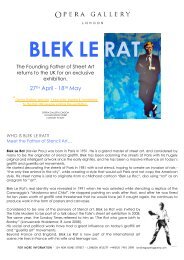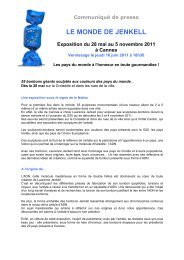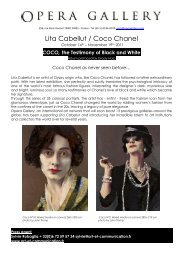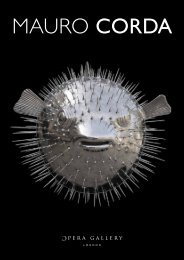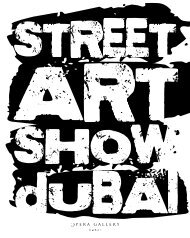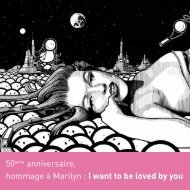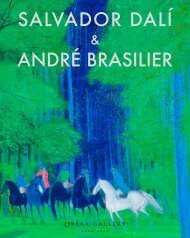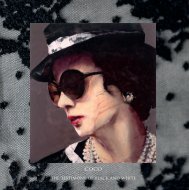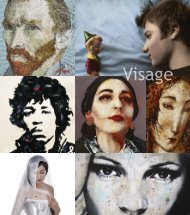Download catalogue - Opera Gallery
Download catalogue - Opera Gallery
Download catalogue - Opera Gallery
You also want an ePaper? Increase the reach of your titles
YUMPU automatically turns print PDFs into web optimized ePapers that Google loves.
<strong>Opera</strong> <strong>Gallery</strong> has been involved in the promotion of Iranian art throughout<br />
the world, and has connections with Iranian descendants living in Tehran. They<br />
have years of experience in curating Iranian art and have constant presence on<br />
Iran’s artscene which gives <strong>Opera</strong> <strong>Gallery</strong> the opportunity to access rare<br />
artworks of established masters and the latest talents of emerging artists on a<br />
constant basis.<br />
The collection exhibited includes two different angles of modern and contemporary<br />
Iranian art. The first approach deals with the transformation of calligraphy from<br />
traditional writing to contemporary art, while the second angle is considering<br />
the divergence of Iranian modern and contemporary art between Western<br />
influences and Iranian roots and culture. You will find a profound evolution in<br />
the Art of Iran during the decades exhibited.<br />
<strong>Opera</strong> <strong>Gallery</strong> Dubai has the pleasure of inviting you to discover the latest and the<br />
best quality of art from Iran in its exhibition which will be held in <strong>Opera</strong> <strong>Gallery</strong><br />
DIFC commencing March 19 th , 2013.<br />
Gilles Dyan<br />
Founder and Chairman, <strong>Opera</strong> <strong>Gallery</strong> Group<br />
Leila Varasteh & Vida Zaim<br />
Curators<br />
2 3
Calligraphy<br />
frOM traditional<br />
writing to<br />
contemporary art<br />
Mohammad EHSAI<br />
Faramarz PILARAM<br />
Nasrollah AFJEHEI<br />
Ali AJALI<br />
Ahmad MOHAMMADPOUR<br />
Mehrdad SHOGHI<br />
Azra Aghighi BAKHSHAYESHI<br />
Mohammad BOZORGI<br />
Mohammad Mahdi YAGHOUBIAN<br />
Behrouz ZINDASHTI<br />
Alireza MOHEBI<br />
p. 6<br />
p. 9<br />
p. 11<br />
p. 12<br />
p. 13<br />
p. 14<br />
p. 15<br />
p. 16<br />
p. 17<br />
p. 18<br />
p. 19<br />
4 5
The logos, the word, the gateway to truth and meaning, it is the sacred geometry of language<br />
and imbued with all the mystical spirituality of the divine. Used principally as a means to<br />
transmit a text, its inherent possibilities of intricate form and aesthetic appeal wove through<br />
underlying talismanic anchors and flourished into myriad ways of exploiting script as ornament.<br />
Denying the thread of consciousness which gave traditional calligraphy its layers of meaning,<br />
another visual landscape is molded out of pure colour where bold letters surge and jostle<br />
against one another in a dichotomy of form and meaning.<br />
Teasing the interplay of decorative elements, one word can give the impression of random<br />
brushstrokes, or a single letter morph into florid knots or floating refrains.<br />
CALLIGRAPHY<br />
is unquestionably<br />
the fundamental<br />
element of Islamic art…<br />
Often illegible or out of context, words free themselves from the strictures of spiritual and poetic<br />
context and become shape for shape’s own sake. In doing so, they make a profound statement<br />
as the art of the word was only ever validated through explicit meaning. Today, a purely visual<br />
movement is replacing the “Written Word” with the “Painted Word” or Naqqashi-khat.<br />
Moving beyond language, the letters are not painted to be understood but to redefine the<br />
ancient roots of their relationship with experience. These singular symbols reject their traditional<br />
reading and redirect the experience to evoke sensations rather than the structural<br />
familiarity of language. Indeed language is actively denied a role in both the expression and<br />
the understanding of the new calligraphy, opening fluid portals to sensory abstraction. Yet<br />
as in the iconography of painting the basic reference points remain intact and meaning is<br />
awoken through re-contextualization. The illusion of infinity running through traditional calligraphy<br />
and the “arabesque” prevails, but legibility is drowned in a sea of form and colour as<br />
seen in the transition between the works of Mohammad Ehsai.<br />
The interwoven letters of Ajali fray into unintelligible heaps of strokes and coils. The floating<br />
letters of Bakhshayeshi rise in isolation and circle through an alchemical abysss as the<br />
intricate incantations of Afjehei merge into a seemingly single stroke of the brush. The<br />
repetitions echo ancient calligraphic exercises but the letters have the majesty of the<br />
spectacular. Theatrical repetition is a fundamental element and yet we also see dramatic<br />
independence as in the work of Mohammad Yaghoubian. In Naqqashi-khat the deliberate<br />
and tranquil contemplation of the unfathomable is quickened through intense colour and<br />
complexity as it drums out a faster, stronger and bolder heartbeat. Yet beneath the loud and<br />
proud odes to modernity whisper the refrains of the timeless, the ancient and the archetypal<br />
as history flowers anew.<br />
Zahra Faridany-Akhavan PhD<br />
6 7
Mohammad EHSAI (1939 -)<br />
Untitled, circa 1960s-1970s<br />
Signed in Farsi (centre)<br />
Mixed media on cardboard (red ink on gold leaf)<br />
40 x 25 cm - 15.7 x 9.8 in.<br />
Provenance<br />
The artist’s studio<br />
Private collection<br />
Mohammad EHSAI (1939 -)<br />
Untitled<br />
Signed in Farsi (lower right); stamped (on the reverse)<br />
Car paint on cardboard<br />
30 x 30 cm - 11.8 x 11.8 in.<br />
Provenance<br />
The artist’s studio<br />
Private collection<br />
8 9
As a modern artist, he employed calligraphy as a drawing. Faramarz Pilaram did not use<br />
motives but only calligraphy using the old “Nastaleeq”*. There is no emphasis on the<br />
meaning, more like a stream of consciousness.<br />
* Nasta liq, also anglicized as Nastaleeq, is one of the main script styles used in writing the Perso-Arabic script,<br />
and traditionally the predominant style in Persian calligraphy.<br />
Faramarz PILARAM (1937 -1982)<br />
Calligraphy, 1972<br />
Signed and dated “Pilaram 72” (lower right)<br />
Oil on cardboard<br />
70 x 70 cm - 27.6 x 27.6 in.<br />
10 11
Calligraphy is the alphabetic elements of a composition. It has<br />
no meaning here. It’s just the music of a composition with the<br />
help of alphabetic painting.<br />
Nasrollah Afjehei<br />
Nasrollah AFJEHEI (1933 -)<br />
Untitled, 2012<br />
Signed in Farsi (centre left)<br />
Acrylic on canvas<br />
90 x 90 cm - 35.4 x 35.4 in.<br />
12 13
Ali AJALI (1939 -)<br />
Untitled, 2012<br />
Signed twice in Farsi (lower left and lower right)<br />
Mixed media on canvas<br />
150 x 200 cm - 59.1 x 78.7 in.<br />
Ahmad MOHAMMADPOUR (1965 -)<br />
Untitled, 2013<br />
Signed in Farsi (lower centre)<br />
Mixed media on canvas<br />
100 x 150 cm - 39.4 x 59.1 in.<br />
14 15
Mehrdad SHOGHI (1972 -)<br />
Untitled, 2008<br />
Stamped and dated “MEHRDAD 2008”; signed and dated in Farsi (lower right)<br />
Mixed media on canvas<br />
200 x 350 cm - 78.7 x 137.8 in.<br />
Azra Aghighi BAKHSHAYESHI (1968 -)<br />
Circumabulation, 2012<br />
Ink on canvas<br />
135 x 135 cm - 53.1 x 53.1 in.<br />
Provenance<br />
The artist’s studio<br />
16 17
Mohammad BOZORGI (1978 -)<br />
Love, 2012<br />
Mixed media on canvas<br />
Diptych: 165 x 235 cm - 65 x 92.5 in.<br />
Mohammad Mahdi YAGHOUBIAN (1974 -)<br />
Untitled, 2012<br />
Signed “Yaghoubian” and signed in Farsi (lower centre)<br />
Acrylic on canvas<br />
136 x 246 cm - 53.5 x 96.8 in.<br />
18 19
Behrouz ZINDASHTI (1978 -)<br />
5 tan, 1391 (2012)<br />
Signed and dated in Farsi (lower centre)<br />
Ink and silver leaf on canvas<br />
200 x 110 cm - 78.7 x 43.3 in.<br />
In this specific work, the “hand” is the symbol of praying<br />
God and the “Mehrab” the symbol of the presence of God<br />
on earth indirectly. However, the artist paints while using<br />
alphabets to make a composition, but there is no emphasis<br />
on the meaning of the calligraphy.<br />
Alireza MOHEBI (1976 -)<br />
Zephyr, 2011<br />
Oil and acrylic on canvas<br />
141 x 190 cm - 55.5 x 74.8 in.<br />
20 21
Reza BANGIZ<br />
Sadegh TABRIZI<br />
Manouchehr NIAZI<br />
Koorosh SHISHEGARAN<br />
Maryam SALOUR<br />
Bahman JALALI<br />
Khosrow HASSANZADEH<br />
Reza DERAKSHANI<br />
Behnam KAMRANI<br />
Amir Hossein HESHMATI<br />
Ali ESMAEILIPOUR<br />
Ghodratollah AGHELI<br />
Samira ALIKHANZADEH<br />
Bijan SAYFOURI<br />
Kourosh GOLNARI<br />
Amirhossein RADAIE<br />
Khosro KHOSRAVI<br />
Alireza FANI<br />
Mojtaba RAMZI<br />
Negar VARASTEH<br />
Shima ESFANDYARI<br />
Vahid DANAIEFAR<br />
p. 24<br />
p. 25<br />
p. 27<br />
p. 29<br />
p. 30<br />
p. 31<br />
p. 32<br />
p. 33<br />
p. 34<br />
p. 35<br />
p. 36<br />
p. 39<br />
p. 40<br />
p. 41<br />
p. 43<br />
p. 44<br />
p. 45<br />
p. 47<br />
p. 48<br />
p. 49<br />
p. 51<br />
p. 52<br />
22 23
Iranian art has undergone<br />
a significant transition<br />
over the last decade…<br />
…as shifts in cultural politics provoke a transformation that is both increasingly reflective and increasingly<br />
critical.<br />
No longer concerned with formalistic innovations derived from Western Art, a distinct sense of self questioning<br />
has opened wide windows onto identity and yielded a new visual language with which to explore it. Irony, satire,<br />
incongruity and subtle spins on the commonplace are being wryly manipulated into fractured comment as<br />
familiar and comfortable iconography is displaced into a new paradigm.<br />
A nascent movement known as “New Art” has injected a radical energy into the Iranian contemporary landscape, as a<br />
superbly subtle engagement with traditional motifs and powerful cultural symbols crystallizes into new angles<br />
of perception. Naturally for Iran, calligraphy, the veil and the chador were an immediate focus for reinterpretation<br />
as the “Contemporary” transitioned from a struggle to stay “in step and time with” Western art to “tuning into”<br />
a self generated and self referential modernity. A distinctly Iranian symbology is instantly recognizable, yet its<br />
use and the hints toward its reading have built toward a decisive shift in meaning. 19 th Century iconography is<br />
imposed with jarring incongruity onto a contemporary moment as acknowledgement and rejection wrestle into<br />
fresh flickers of volatile unity. Collective memory is invoked and bygone priorities are woven through splintered<br />
personal histories as Iranian art strives to reconcile its uneasy relationship to the Western tradition with its own<br />
roots and break through into individuality.<br />
The ubiquity of the familiar is offset by discordant notes as unpredictable juxtapositions unsettle the viewer into<br />
a probing reappraisal of that familiarity. In the work of Khosro Khosravi, the cloaked commentary on the<br />
futility of the chador literally lays bare prohibited areas. Hidden behind full veils Radaie’s 19 th Century costumed<br />
women speak to the “inability of people to determine their destinies”.<br />
Autobiographical narratives probe uneasy connections and fragile identities through jagged shards of broken<br />
memory. The mirrored fragments which pervade the work of Negar Varasteh are a deliberately warped looking<br />
glass into reality just as the recognizable landmarks of past eras co-exist yet conflict with their setting in the<br />
bank notes of Behnam Kamrani. Photographs, the most commonplace representation of collective memory are<br />
blinded or stare into the impenetrable narratives of Samira Alikhanzadeh and Bahman Jalali or take new vistas<br />
over the distant landscapes of Khosrow Hassanzadeh’s, or indeed shine an elusive light into Shima Esfandyari’s<br />
cultural consciousness.<br />
The national symbols that characterized the work of earlier artists such as Sadegh Tabrizi have been dislodged and<br />
replanted onto an “alien” landscape, and yet that “foreignness” is no longer the derivative of Western ideas but<br />
a mutation of Iran’s own cultural lexicon. Even at modernity’s peak, the intangible connection of the Iranian<br />
artist to his cultural context is undeniable. Through the cracking and peeling of Reza Derakhshani’s and distill<br />
of Mohammad Niazi’s cutting edge, an elusive nostalgia pervades. This duality of a culture in which nothing is<br />
as it seems, has given rise to unapologetic self exploration reveling in the double entendre and the allegorical.<br />
Emotional and psychological interaction with the viewer’s collective consciousness, twisted into incisive<br />
illusions and raw reflections are the common thread running through contemporary Iranian art. As it casts off<br />
the shackles of imported ideas and indigenous inertia through a progressive cycle of disintegration and resurrection,<br />
we are seeing a different dynamic of complexity and ambiguity fighting for a new understanding, a new<br />
sense and a new integrity of self.<br />
Zahra Faridany-Akhavan PhD<br />
24 25
Old miniature while using a sentence that still has no meaning just<br />
as a decor for the borders as used to be in old Iranian miniature.<br />
Reza BANGIZ (1937 -)<br />
The fourth wife, 1387 (2008)<br />
Signed (lower left)<br />
Engraving and print on canvas<br />
150 x 90 cm - 59.1 x 35.4 in.<br />
Sadegh TABRIZI (1939 -)<br />
Raiders, 1988<br />
Signed and dated “S. Tabrizi 88” (lower right corner)<br />
Oil on canvas<br />
70 x 100 cm - 27.6 x 39.4 in.<br />
Provenance<br />
The artist’s studio<br />
Private collection<br />
26 27
Manouchehr Niazi is a master artist<br />
who has been creating paintings for<br />
the last 61 consecutive years. His<br />
last collection, featuring demolishing<br />
human crowds or figures indicating<br />
ever increasing decadence and<br />
futility, has been strongly influenced<br />
by the phenomenon “the Arabian<br />
Spring” and the occurring incidents<br />
in the region. The majority of<br />
his artworks are sole colour oil painting<br />
harmonies on canvas.<br />
Manouchehr NIAZI (1936 -)<br />
Untitled<br />
Signed (lower right corner)<br />
Oil on canvas<br />
100 x 150 cm - 39.4 x 59.1 in.<br />
28 29
Shishegaran’s world is a vivid matrix of fluid dynamics and channelled complexity,<br />
where word, pattern, geometry and colour synthesise into a torrid<br />
visual language. Harnessing the myriad cultural legacies of his native Iran, he<br />
shoots fragments of the Orient through the contemporary prism of pop art<br />
and modernism with a freestyle nod to graffiti woven into the ride. Exploring<br />
the essence of line, pattern and subjective meaning within a set of personal<br />
“rules” about the courtship of calligraphy, his bold tapestries of form distil<br />
into profoundly human moments as hints of portraiture peek out from behind<br />
the oscillating folds.<br />
Zahra Faridany-Akhavan PhD<br />
Koorosh SHISHEGARAN (1945 -)<br />
Green head, 2009<br />
Signed “Koorosh” and signed in Farsi (lower left corner)<br />
Acrylic on canvas<br />
170 x 120 cm - 66.9 x 47.2 in.<br />
30 31
Maryam SALOUR (1954 -)<br />
Devil & Angel, 2011<br />
Signed “MSalour” (on the reverse)<br />
Ceramic, unique piece<br />
70 x 20 x 8 cm - 27.6 x 7.9 x 3.1 in.<br />
Bahman JALALI (1944 - 2010)<br />
Image of imagination series, 2005<br />
Signed<br />
Chromatic print, edition of 10<br />
70 x 70 cm - 27.6 x 27.6 in.<br />
Provenance<br />
The artist’s studio<br />
Private collection<br />
32 33
Khosrow HASSANZADEH (1963 -)<br />
Terrorist Najibeh, 2004<br />
Mixed media on canvas<br />
300 x 220 cm - 118.1 x 86.6 in.<br />
Reza DERAKSHANI (1952 -)<br />
Pir o Tarsa, 2008<br />
Signed and dated “08” (upper right corner);<br />
signed and dated “REZA DERAKSHANI 2008” (on the reverse)<br />
Mixed media on canvas<br />
180 x 200 cm - 70.9 x 78.7 in.<br />
34 35
In this series, the artist takes a critical and<br />
ironical approach using the landscape of<br />
old Iranian banknotes to use the historical<br />
glory and grander of these monuments not<br />
only into the reflection of his own cultural<br />
demands, but also his society, and more<br />
generally a period. Each work of art in the<br />
series consists of painting on high resolution<br />
print on canvas of the back side of a used<br />
bank note from the Pahlavi period.<br />
When logic and emotion collide, one has to read<br />
between the lines. Innuendos take over, fallacious<br />
arguments begin and judgment suffers.<br />
Behnam KAMRANI (1968 -)<br />
With Persepolis, 2010<br />
Signed in Farsi (lower left)<br />
Acrylic on printed canvas<br />
82 x 171 cm - 32.3 x 67.3 in.<br />
Amir Hossein HESHMATI (1961 -)<br />
Evidence? From Innuendo collection, 2011<br />
Signed (on the reverse)<br />
Print on Fine Art paper, edition of 3<br />
50 x 75 cm - 19.7 x 29.5 in.<br />
Provenance<br />
The artist’s studio<br />
34 35
Ali ESMAEILIPOUR (1962 -)<br />
Reflection of life and truth<br />
Titled “Reflection of life and truth” (on the reverse)<br />
Acrylic on linen and wood with gold leaf<br />
Triptych: 130 x 256 cm - 51.2 x 100.8 in.<br />
38 39
Agheli always seeks signs and symbols to achieve<br />
narrative images. The motifs are familiar and<br />
legible in terms of representational features and<br />
symbolic implications. The body implies by most<br />
classical sense the Iranian icon “Takhti” and the<br />
lion represents the certain symbols of ethnic and<br />
historical significances.<br />
Ghodratollah AGHELI (1968 -)<br />
From the collection of Venus in the tragic land, 2012<br />
Signed (on the left side)<br />
Bronze and brass engraved, edition of 3<br />
18 x 70 x 53 cm - 7.1 x 27.6 x 20.9 in.<br />
Provenance<br />
The artist’s studio<br />
40 41
Samira ALIKHANZADEH (1967 -)<br />
From the Family album series, 2010<br />
Acrylic and mirror fragments on printed board, edition of 3<br />
120 x 150 cm - 47.2 x 59.1 in.<br />
Bijan SAYFOURI (1968 -)<br />
Righteous injustice, from General defection series, 2011<br />
Stamped with the artist monogram (centre left); signed “Bijan Sayfouri” and stamped (on the reverse)<br />
Agfa Anapurna MV print on HP artist matte canvas, edition of 4 + 1 AP<br />
140 x 140 cm - 55.1 x 55.1 in.<br />
42 43
Marathon is a dazzling triple sculpture from the “Sovereign” exhibition in which<br />
rulers are summoned before the viewer, and provide an opportunity to ponder the<br />
history of rulers in Iran. These rulers are faceless and emotionless, but are filled<br />
with characters beyond their chosen names. Sovereigns are legends with various<br />
names and personas that are often contradictory qualities. Protecting by nature,<br />
but bound by power, glory, and glitter.<br />
Kourosh GOLNARI (1963 -)<br />
Marathon, 2011<br />
Signed (on the back)<br />
Coins, edition of 5<br />
90 x 48 x 30 cm - 35.4 x 18.9 x 11.8 in.<br />
Provenance<br />
The artist’s studio<br />
44 45
Amirhossein RADAIE (1986 -)<br />
From the Fortune teller series, 2013<br />
Signed (on the bottom of the right side of the veil)<br />
Bronze and cast iron, edition of 5<br />
37 x 25 x 25 cm - 14.6 x 9.8 x 9.8 in.<br />
Khosro KHOSRAVI (1965 -)<br />
From floral veil series, 2012<br />
Signed<br />
Acrylic on canvas<br />
170 x 125 cm - 66.9 x 49.2 in.<br />
46 47
I spent my childhood and adolescence<br />
sometime in the city, sometime in my<br />
father’s farm. In those years I was so<br />
detailed-oriented that every thing<br />
interested me: a river fish, my father’s<br />
old calculator, the goose wish bone that<br />
my mother was cooking and so on. In<br />
those years my interpretations were one<br />
at a time and everything extraordinary<br />
seemed normal. Today, my recollections<br />
are interwoven, forming a language or an<br />
illusional message, which I consider more<br />
real than the reality.<br />
Alireza Fani<br />
Alireza FANI (1975 -)<br />
Play time, from the Illusion series, Spring 2010<br />
Signed and numbered ‘Alireza Fani /4’ (on the reverse)<br />
Pigment inkjet print on Premium Luster 260 gr., edition of 4 + 1 EA<br />
150 x 100 cm - 59.1 x 39.4 in.<br />
Provenance<br />
The artist’s studio<br />
48 49
Mirror is a metaphor for light and<br />
lucidity. Once you immerse in this<br />
radiance and glow, it appears as if<br />
you have reached the other side, for<br />
this perception you need to believe in<br />
light.<br />
Negar Varasteh<br />
Mojtaba RAMZI (1988 -)<br />
Blind knight, 2012<br />
Signed, dated and numbered “Moji Ramzi 2012 /5” (under the tail)<br />
Bronze, edition of 5<br />
27,5 x 22 x 14 cm - 10.8 x 8.7 x 5.5 in.<br />
Negar VARASTEH (1975 -)<br />
Rezgh, 2012<br />
Signed (on the reverse)<br />
Mirror work on printed canvas, unique piece<br />
4 panels of 60 x 60 cm - 23.6 x 23.6 in.<br />
50 51
This project consists of painting-installations on plexiglas in which<br />
metal wires have been used in some. With a proper lighting, an atmosphere<br />
has been created that expresses the artist’s main theme. The<br />
shadows which are created by the means of the lighting thrown on<br />
the shapes portray different expression. These shadows, combined with<br />
the paintings, create a duality in emotion for the viewers and show a<br />
variety of body shapes. These various personalities that are unseen to<br />
us or hidden and denied by ourselves follow us like shadows and at<br />
times mingle with our real self. They are made up of our own thoughts<br />
and beliefs and have severed our roots. They are behind us and with<br />
their strings of fear and doubt hold our lives and fate in their hands<br />
and they whisper in our ears that we are alone and yet many bodies in<br />
our loneliness.<br />
Shima ESFANDYARI (1977 -)<br />
Bodies, 1391 (2012)<br />
Signed and dated in Farsi “Shima Esfandyari 91” (upper right)<br />
Oil on plexiglas with video projection<br />
120 x 90 cm - 47.2 x 35.4 in.<br />
52 53
54<br />
Vahid DANAIEFAR (1983 -)<br />
TV screen series, 2010<br />
Signed and dated “Danaefir 2010” (on the stretcher)<br />
Oil on canvas<br />
50 x 60 cm - 19.7 x 23.6 in.



